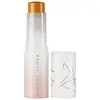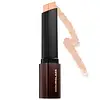Fenty Beauty Eaze Drop Blur + Smooth Tint Stick Versus Hourglass Cosmetics Hourglass Vanish Seamless Foundation Stick
What's inside
What's inside
 Key Ingredients
Key Ingredients

 Benefits
Benefits

 Concerns
Concerns

 Ingredients Side-by-side
Ingredients Side-by-side

Dimethicone
EmollientOctyldodecanol
EmollientSynthetic Wax
AbrasiveAluminum Starch Octenylsuccinate
AbsorbentSilica
AbrasiveEthylene/Propylene Copolymer
AbrasiveDisteardimonium Hectorite
StabilisingAstrocaryum Murumuru Seed Butter
EmollientPentaerythrityl Tetra-Di-T-Butyl Hydroxyhydrocinnamate
AntioxidantCaprylic/Capric Triglyceride
MaskingRicinus Communis Seed Oil
MaskingSodium Hyaluronate
HumectantSilica Dimethyl Silylate
EmollientPolyhydroxystearic Acid
EmulsifyingHydrogenated Castor Oil
EmollientPsidium Guajava Fruit Extract
AstringentTocopherol
AntioxidantCI 77891
Cosmetic ColorantIron Oxides
Dimethicone, Octyldodecanol, Synthetic Wax, Aluminum Starch Octenylsuccinate, Silica, Ethylene/Propylene Copolymer, Disteardimonium Hectorite, Astrocaryum Murumuru Seed Butter, Pentaerythrityl Tetra-Di-T-Butyl Hydroxyhydrocinnamate, Caprylic/Capric Triglyceride, Ricinus Communis Seed Oil, Sodium Hyaluronate, Silica Dimethyl Silylate, Polyhydroxystearic Acid, Hydrogenated Castor Oil, Psidium Guajava Fruit Extract, Tocopherol, CI 77891, Iron Oxides
Phenyl Trimethicone
Skin ConditioningC12-15 Alkyl Ethylhexanoate
EmollientCaprylic/Capric Triglyceride
MaskingEthylhexyl Methoxycinnamate
UV AbsorberEuphorbia Cerifera Wax
Ceresin
Emulsion StabilisingPolyethylene
AbrasivePentylene Glycol
Skin ConditioningMicrocrystalline Wax
Emulsion StabilisingPolyglyceryl-2 Triisostearate
EmulsifyingVp/Hexadecene Copolymer
Methyl Methacrylate Crosspolymer
1,2-Hexanediol
Skin ConditioningAluminum Hydroxide
EmollientBHT
AntioxidantCaprylyl Glycol
EmollientDimethicone
EmollientEthylhexylglycerin
Skin ConditioningIllicium Verum Fruit Extract
PerfumingIsostearyl Alcohol
EmollientLauryl Laurate
Skin ConditioningLauryl PEG/PPG-18/18 Methicone
Skin ConditioningMacadamia Seed Oil Polyglyceryl-6 Esters Behenate
EmollientMethicone
EmollientMica
Cosmetic ColorantPhenoxyethanol
PreservativePropanediol
SolventSilica
AbrasiveTalc
AbrasiveTriethoxycaprylylsilane
Iron Oxides
CI 77891
Cosmetic ColorantPhenyl Trimethicone, C12-15 Alkyl Ethylhexanoate, Caprylic/Capric Triglyceride, Ethylhexyl Methoxycinnamate, Euphorbia Cerifera Wax, Ceresin, Polyethylene, Pentylene Glycol, Microcrystalline Wax, Polyglyceryl-2 Triisostearate, Vp/Hexadecene Copolymer, Methyl Methacrylate Crosspolymer, 1,2-Hexanediol, Aluminum Hydroxide, BHT, Caprylyl Glycol, Dimethicone, Ethylhexylglycerin, Illicium Verum Fruit Extract, Isostearyl Alcohol, Lauryl Laurate, Lauryl PEG/PPG-18/18 Methicone, Macadamia Seed Oil Polyglyceryl-6 Esters Behenate, Methicone, Mica, Phenoxyethanol, Propanediol, Silica, Talc, Triethoxycaprylylsilane, Iron Oxides, CI 77891
Alternatives
Ingredients Explained
These ingredients are found in both products.
Ingredients higher up in an ingredient list are typically present in a larger amount.
This ingredient is an emollient, solvent, and texture enhancer. It is considered a skin-softener by helping the skin prevent moisture loss.
It helps thicken a product's formula and makes it easier to spread by dissolving clumping compounds.
Caprylic Triglyceride is made by combining glycerin with coconut oil, forming a clear liquid.
While there is an assumption Caprylic Triglyceride can clog pores due to it being derived from coconut oil, there is no research supporting this.
Learn more about Caprylic/Capric TriglycerideCi 77891 is a white pigment from Titanium dioxide. It is naturally found in minerals such as rutile and ilmenite.
It's main function is to add a white color to cosmetics. It can also be mixed with other colors to create different shades.
Ci 77891 is commonly found in sunscreens due to its ability to block UV rays.
Learn more about CI 77891Dimethicone is a type of synthetic silicone created from natural materials such as quartz.
What it does:
Dimethicone comes in different viscosities:
Depending on the viscosity, dimethicone has different properties.
Ingredients lists don't always show which type is used, so we recommend reaching out to the brand if you have questions about the viscosity.
This ingredient is unlikely to cause irritation because it does not get absorbed into skin. However, people with silicone allergies should be careful about using this ingredient.
Note: Dimethicone may contribute to pilling. This is because it is not oil or water soluble, so pilling may occur when layered with products. When mixed with heavy oils in a formula, the outcome is also quite greasy.
Learn more about DimethiconeSilica, also known as silicon dioxide, is a naturally occurring mineral. It is used as a fine, spherical, and porous powder in cosmetics.
Though it has exfoliant properties, the function of silica varies depending on the product.
The unique structure of silica enhances the spreadability and adds smoothness, making it a great texture enhancer.
It is also used as an active carrier, emulsifier, and mattifier due to its ability to absorb excess oil.
In some products, tiny microneedles called spicules are made from silica or hydrolyzed sponge. When you rub them in, they lightly polish away dead skin layers and enhance the penetration of active ingredients.
Learn more about SilicaThis ingredient is a combination of red, black, and yellow iron oxide pigments. This combination of colors is usually found in foundation, because it results in a "skin" color.